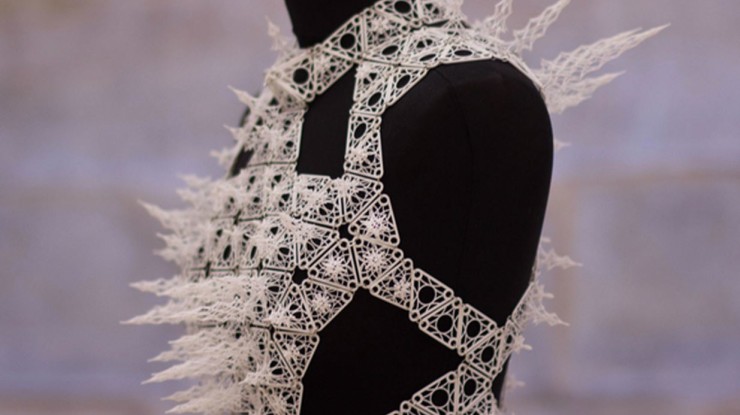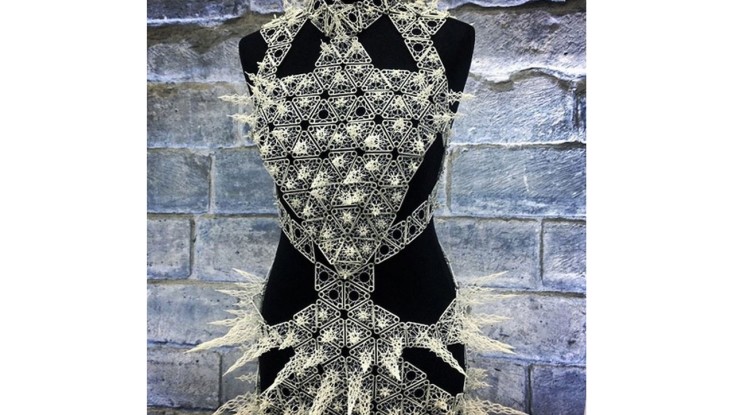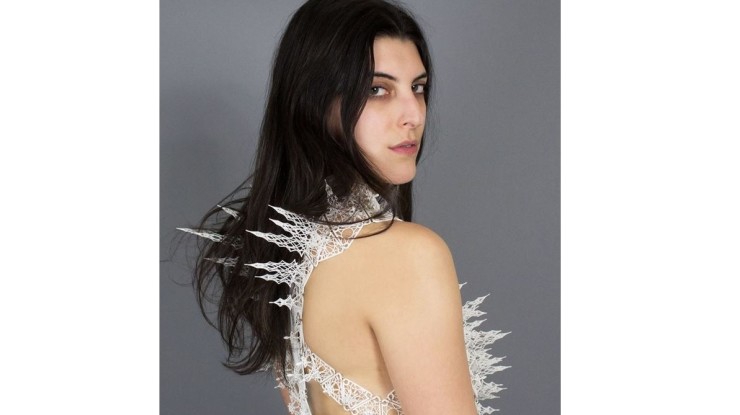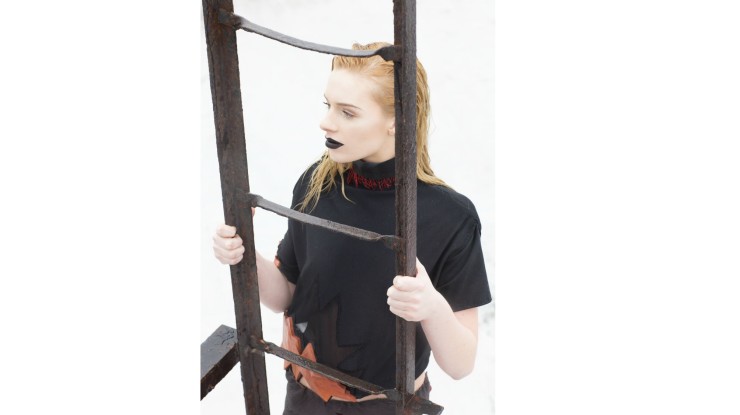Prepping for her debut at London’s new INTERLACED event in September, Alexis Walsh is certainly no stranger to technology, nor is she a conventional fashion designer. The New York City based artist concentrates on ‘wearable design with an integration of sculptural forms’ using an ‘interdisciplinary approach to fabrication’, something immediately evident in her latest LYSIS Collection.
With designs worn by the likes of Lady Gaga, the up and comer initially caught our eye with her intricate 3D printed structures, combined with her distinctive sartorial styling. Whilst 3D printed fashion is not a new concept, Walsh manages to bring an almost organic feel to the process, with the resulting pieces nothing short of eye-catching.
Our 3D Technology Consultant, Jay Short, spoke with the designer recently about her inspiration and where she hopes to take the techology next.
1) Describe your design style in 3 words.
Sculptural, handcraft, contradictory
2) What are you up to at the moment work-wise?
Right now I’m doing freelance work for the RTW Product Development and Design teams at Proenza Schouler, and doing freelance Textile Design for Lululemon Athletica.
3) When I talk to our clients about 3D printing, I often cite you as a pioneer in the industry and someone who should be a role model for those who wish to creatively use the technology. Who were your role models from a design perspective?
Thank you! My most crucial role model is Alexander McQueen, he was a creative genius and played a pivotal role in the re-invigoration of avant garde and wearable art into fashion design. Iris van Herpen, who has melded 3D printing into haute couture fashion design, is also endlessly inspiring.
4) The Spire dress was the first time we saw your work and the most appealing aspect for me was how it was a beautiful piece of design that perfectly complemented the use of 3D printing. What first attracted you to using 3D printing as a tool in your designs?
I’ve always been interested in traditional fine arts, specifically sculpture, and was looking for a way to incorporate these skill sets into structural garments. For a while, I had experimented with wearable sculptures. I made garments from wood, a cage dress welded from steel rods, and a corset from aluminum sheeting. When I learned about 3D printing, it seemed like the natural step in the progression of my designs. I saw 3D printing as a way to achieve forms that would be impossible to create otherwise.
5) What came first for you, the idea of using 3D printing as a medium, or a design concept in your mind which you then realised could be most simply/effectively realised through 3D printing?
l was definitely attracted to the idea of 3D printing as a medium first, which then informed the design concept. The Spire Dress was my first 3D printed piece, and it was a collaboration between my good friend Ross Leonardy and I. Before starting the design process, neither of us had any experience with CAD modeling software. We had to teach ourselves to use programs like Rhinoceros3D and Grasshopper, and the design of the tiled pieces for Spire Dress evolved as we explored our capabilities. The form of the final structure was determined last, after the individual pieces had been modeled and printed.
6) Describe the initial reactions when you first suggested using 3D printing in your designs?
No one had any idea what I was talking about. I became interested in 3D printing in 2013, while I was still a student at Parsons The New School for Design. Having studied both fashion design and product design, this seemed like the perfect combination of my skills, and the challenge behind it was part of the reason that I found the idea of 3D printing for fashion so appealing. Professors and friends in my fashion design classes had never heard of 3D printing and thought it sounded like a cheap gimmick, while professors and friends in my product design courses had only seen 3D printing utilized for rapid prototyping, and couldn’t imagine making a garment. People didn’t fully “get” it until the Spire Dress was completed and Ross and I had shot our photoshoot for the piece. Then everyone was like, “Wait, this is actually really cool….”
7) What was the rationale behind choosing the type of 3D printers you have used in your designs and why were these materials chosen?
For the Spire Dress, the early prototypes for the tiled pieces were made using a MakerBot Replicator2 printer. This choice was made entirely from convenience, because Parsons has 9 MakerBots in one of their buildings. After the prototyping stage, the final designs were printed using Shapeways. The complexity of the modeled forms could only be printed using SLS (Selective Laser Sintering) fabrication processes. I was happy with the quality of the printed pieces for the Spire Dress, and decided to use Shapeways again to 3D print the modular components for my LYSIS Collection. For this collection, I chose a nylon material because I wanted to custom-dye the parts for my new collection by hand, and nylon accepts coloring in a way that is very similar to fabric dyeing.
8) You have used the 3Doodler pen in your work. It is the first time we have seen it used to actually create something that doesn’t look like the work of a 4 year old. Where did you find out about this ‘tool’?
I had seen the Kickstarter campaign for the first 3Doodler pen, and immediately thought of the trim applications it could be useful for. I was given the pen as a gift after one of my runway shows, and started to experiment with it. I used the 3Doodler to create textural trim, almost like an embroidery or applique, on some of the leather pieces used in my LYSIS Collection. The collection was just published in an editorial feature for the Berlin-based fashion mag KALTBLUT MAGAZINE, where a belt with details made from the 3Doodler can be seen.
9) What do you think is restricting 3D printing from becoming more prevalent within the fashion industry?
There’s still a lack of overlap between the 3D printing industry and the fashion industry. Designers in fashion are interested in the technology, but it’s from such a different world and different set of technical skills. This is a generalization, but fashion designers do not usually have backgrounds in 3D modeling and coding, and 3D printing designers do not usually have intricate knowledge of garment construction, patternmaking, and draping. Right now, I think that the main restriction is due to a lack of integration from either side of the spectrum. However, this is beginning to change thanks to a few pioneering fashion designers who have utilized the technology for their collections or runway shows, most notably Chanel’s usage of 3D printing in their latest Haute Couture runway show.
10) Do you envision 3D printing playing an important part in your future projects or do you think you will potentially explore other technologies, or move towards more traditional design methods.
3D printing will definitely play an important role in my future, but I am also very drawn to traditional fashion design. I would like to create more work similar to my LYSIS Collection, which combined 3D printing with garments that were entirely hand-sewn and traditionally handcrafted.
11) Where does Alexis Walsh hope to be in 12 months time?
In 12 months, I’ll hopefully be continuing to do freelance design for fashion brands while further establishing my own designs. Ross and I have also been discussing the idea of collaborating again to create a 3D printed jewellery and accessories line. I’d like to be working with more leather too.
To find out more about Alexis’ work, head over to www.alexiswalsh.com







